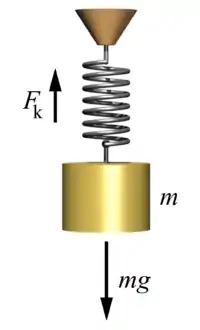< Fundamental Physics < Force 

Fk is the force that responds to the load on the spring
An elastic force acts to return a spring to its natural length. An ideal spring is taken to be massless, frictionless, unbreakable, and infinitely stretchable. Such springs exert forces that push when contracted, or pull when extended, in proportion to the displacement of the spring from its equilibrium position.
This linear relationship was described by Robert Hooke in 1676, for whom Hooke's law is named. If is the displacement, the force exerted by an ideal spring equals:
where
- is the spring constant (or force constant), which is particular to the spring
- The minus sign (-) accounts for the tendency of the force to act in opposition to the applied load.
- . Vertical Displacement
This article is issued from Wikiversity. The text is licensed under Creative Commons - Attribution - Sharealike. Additional terms may apply for the media files.